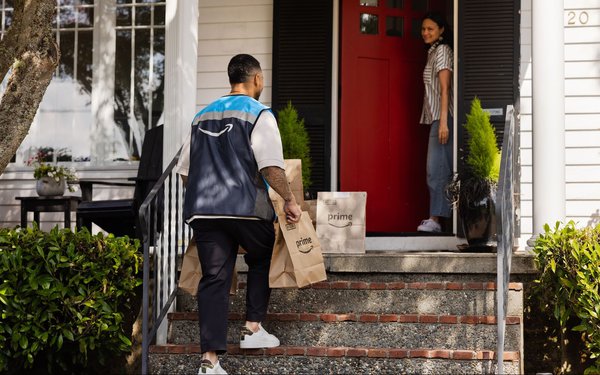
Amazon is making one of its
boldest fresh-grocery moves yet, rolling out same-day delivery of perishable groceries to 1,000 U.S. cities and towns. The expansion—free for Prime members on orders over $25 and $2.99 for
smaller orders—will reach 2,300 locations by year’s end.
The move puts new pressure on Walmart, Kroger, Instacart, and DoorDash, all of which have
invested heavily in grocery delivery. While Amazon has offered fresh items via Amazon Fresh and Whole Foods Market stores for years, this marks its broadest push into perishables—and a sign it
may have finally cracked the logistics code.
Bigger Baskets, Higher Frequency
Doug Herrington, CEO of Worldwide Amazon Stores, frames the expansion as a way to simplify mealtime—and drive bigger orders. “You can order cookware for Same-Day
Delivery, but now you can add everything for grandma’s chicken soup—fresh veggies, broth, noodles, herbs, chicken, even bowls to serve it in,” he says in the company’s
announcement. “Just add what you need in one order, and we handle the rest.”
advertisement
advertisement
The idea is to make fresh groceries just another click for Prime
members already buying electronics, apparel, or home goods. By reducing the friction between pantry staples and perishables, Amazon hopes to encourage shoppers to make it their go-to
grocer—without the extra trip to Walmart or Kroger.
Competitive Ripples
The announcement rattled competitors. “Walmart and Instacart should be worried,” writes Barron’s, noting that grocery has been “the last frontier for Amazon.” And while
Walmart, Kroger, Albertsons and Publix all outstrip Amazon’s market share in the broader grocery category, “the tech giant is doing much better online, giving top digital grocer Walmart a
run for its money. Walmart captures about 32% of U.S. e-commerce grocery sales and Amazon is a close second with 22.6%.”
Amazon’s test markets offer a hint of its ambitions. In
cities like Phoenix, Orlando, and Kansas City, where fresh same-day delivery has been piloted, Amazon says first-time grocery buyers doubled their repeat shopping rate compared with customers who
didn’t order fresh items.
A Long Time Coming
Ever since its $13.7
billion acquisition of Whole Foods in 2017, Amazon has been seen as a looming grocery disruptor. But despite experimenting with physical formats and tweaking the Amazon Fresh concept, it hasn’t
found its footing —especially for perishables. “The reason this announcement is so significant is that Amazon has yet to displace incumbents in the grocery category, at least for
perishables,” writes Scott Devitt, an analyst who follows Amazon for Wedbush. “Grocery is the biggest retail category and still relatively untouched by the internet. Walmart generates 60%
of sales from the grocery category and has done a great job building a delivery/pickup business.”
Amazon’s edge, Devitt notes, is its national network of fulfillment centers and
delivery trucks. “It seems to have finally figured out how to store and fulfill perishables in a way to support same-day efforts.”
The Stakes in a $1 Trillion Market
Americans spent $1.09 trillion on food consumed at home last year, according to the
U.S. Department of Agriculture. It’s an enormous prize, but grocery is also notoriously low-margin and fiercely competitive, with consumers deeply attached to their shopping habits.
And while newer players like DoorDash and Instacart have built large user bases, legacy chains—especially Walmart, Target, and Kroger—have significantly
upgraded their ecommerce operations. Walmart, for example, can now make same-day grocery deliveries to 90% of Americans, reports the Wall Street Journal, which points out that investors’ patience is wearing
thin with Amazon on the grocery business.
That’s helped Walmart remain the category leader, including online: eMarketer estimates Walmart controls 32% of U.S. ecommerce grocery sales,
with Amazon close behind at 22.6%. Yet even among Prime members, Walmart is often the first choice for groceries. Emarketer cites Brick Meets Click/Mercatus data that shows roughly 70% of digital
shoppers bought food or beverages from Walmart in June, compared with 54% for Amazon. Walmart’s share as a “primary grocer” even ticked up in June, including among more affluent
households.
A Digital Grocery Arms Race
The next months will show
whether Amazon’s scale can overcome entrenched shopper loyalties. Walmart’s price leadership and store network remain formidable, especially at a moment when consumers are eager to lower
food costs. And Instacart’s partnerships give it reach across hundreds of regional grocers. But if Amazon can consistently deliver fresh food quickly, affordably, and with the same reliability
it brings to electronics or books, the online grocery leaderboard could shift fast.
For now, Amazon has signaled it’s done tinkering and ready to play
offense in perishables. For its competitors, that’s the real bombshell.